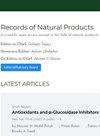山Alphonsea monogyma Merr.&来自越南的Chun和Goniothalamus banii B.H.Quang,R.K.Choudhary和V.T.Chinh
IF 1.5
4区 生物学
Q3 CHEMISTRY, APPLIED
引用次数: 1
摘要
:来自Alphonsea monogyma Merr叶子的精油。&以越南产的Chun和Goniothalamus banii B.H.Quang、R.K.Choudhary和V.T.Chinh为原料,采用气相色谱(GC)和气相色谱-质谱联用(GC/MS)测定其化学成分。采用微量稀释肉汤法进行抗菌试验。精油的产率分别为0.18%(v/w)和0.355%(v/w。A.monogyma的主要成分为(E)-石竹烯(13.8%), -桂树精油的主要成分为月桂烯(47.1%)、α-蒎烯(9.7%)和(E)-石竹烯(9.1%)。A.monogyma的叶精油对粪肠球菌ATCC29212、金黄色葡萄球菌ATCC25923和蜡样芽孢杆菌ATCC14579的革兰氏阳性微生物显示出强大的抗菌活性,最小抑菌浓度(MIC)值分别为2.23µg/mL、10.45µg/mL和10.33µg/mL。另一方面,banii精油对革兰氏阴性铜绿假单胞菌ATCC27853(MIC 5.67µG/mL)表现出最有效的抗菌作用,对白色念珠菌ATCC10231(MIC 32.67µG/mL。首次报道了A.monogyma和G.banii精油的化学成分和抗菌活性。本文章由计算机程序翻译,如有差异,请以英文原文为准。
Essential Oil Compositions and Antimicrobial Activity of the Leaves of Alphonsea monogyma Merr. & Chun and Goniothalamus banii B. H. Quang, R. K. Choudhary & V.T. Chinh from Vietnam
: Essential oils from the leaves of Alphonsea monogyma Merr. & Chun and Goniothalamus banii B. H. Quang, R. K. Choudhary & V.T. Chinh from Vietnam were obtained by hydrodisitllation and the chemical components determined by gas chromatography (GC) and gas chromatography coupled with mass spectrometry (GC/MS). The antimicrobial assay was conducted by microdilution broth method. The respective yields of the essential oils were 0.18% (v/w) and 0.355% (v/w), respectively. The major components of A. monogyma were ( E )-caryophyllene (13.8%), -cadinene (12.5%), bicyclogermacrene (12.4%), cis -β-elemene (12.1%), and germacrene D (11.4%). However, myrcene (47.1%), α-pinene (9.7%) and ( E )-caryophyllene (9.1%) were the dominant constituents of the essential oil of G. banii . The leaf essential oil of A. monogyma displayed potent antimicrobial activity towards the Gram-positive microorganisms of Enterococcus faecalis ATCC29212, Staphylococcus aureus ATCC25923 and Bacillus cereus ATCC14579 with minimum inhibitory concentration (MIC) values of 2.23 µg/mL, 10.45 µg/mL and 10.33 µg/mL, respectively. On the other hand, essential oil from G. banii exhibited the most effective antibacterial against Gram-negative Pseudomonas aeruginosa ATCC27853 (MIC 5.67 µg/mL), and anti-candidal action towards Candida albicans ATCC10231 (MIC 32.67 µg/mL). The chemical constituents and antimicrobial activity of the essential oils of A. monogyma and G. banii were being reported for the first time.
求助全文
通过发布文献求助,成功后即可免费获取论文全文。
去求助
来源期刊

Records of Natural Products
生物-医药化学
CiteScore
3.10
自引率
26.30%
发文量
78
审稿时长
4 months
期刊介绍:
Records of Natural Products is a journal of natural product chemistry. Reviews, book reviews, research papers and short reports are considered on the substances of plants, microbes and animals.
Discussions on the structure elucidation, synthesis of naturally occurring compounds and biological activity of natural compounds and plant extracts, biosynthesis of natural products and essential oils of aromatic plants as well as chemotaxonomy in the field of plants are welcomed in the journal.
All published research articles in Records of Natural Products have undergone rigorous peer review, based on initial editor screening and anonymized refereeing by expert referees.
 求助内容:
求助内容: 应助结果提醒方式:
应助结果提醒方式:


